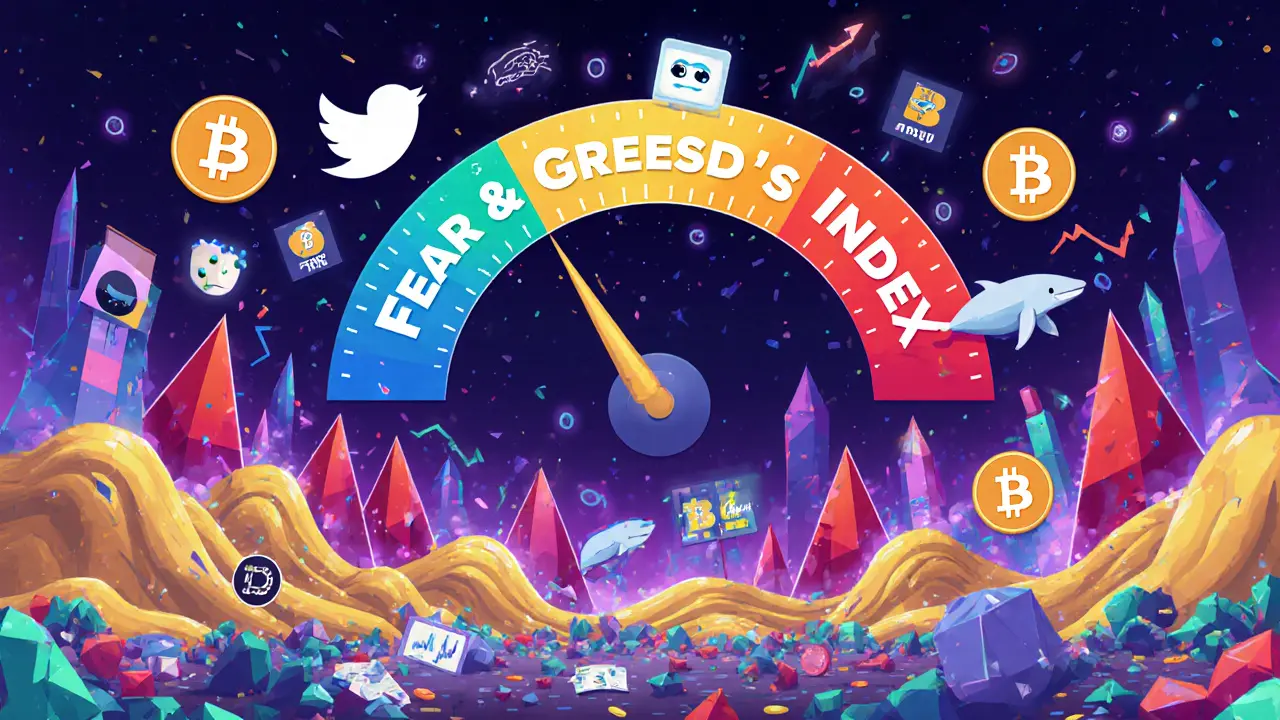When Bitcoin jumped $6,000 in a single day after Elon Musk tweeted a Bitcoin emoji, it wasn’t because of new regulations, upgrades, or earnings reports. It was because of sentiment. Crypto markets don’t move on fundamentals alone-they move on fear, excitement, FOMO, and panic. That’s where crypto market sentiment analysis comes in.
What Exactly Is Crypto Market Sentiment Analysis?
Crypto market sentiment analysis is the practice of measuring the mood of traders and investors to predict price movements. Unlike technical analysis, which looks at charts and candlesticks, or fundamental analysis, which checks whitepapers and team backgrounds, sentiment analysis digs into human behavior. It asks: Are people excited? Afraid? Confused? Angry? And then it turns those feelings into data. The crypto market has no central bank, no corporate earnings calls, and no government oversight in most places. That makes it wild. Prices swing based on tweets, YouTube videos, Reddit threads, and even memes. Sentiment analysis gives you a way to read the room-even when the room is spread across Twitter, Discord, and Telegram.How Is Sentiment Measured?
There are five main ways analysts measure crypto sentiment, each with its own strengths and blind spots.- Social Media Monitoring: Tools like LunarCrush scan over a million posts daily from Twitter (X), Reddit, and Telegram. They count how often a coin is mentioned and whether the tone is positive or negative. A spike in “HODL” or “to the moon” posts can signal rising excitement. A flood of “dumping” or “scam” comments might mean trouble.
- News Analysis: Platforms like CoinDesk and CoinTelegraph are monitored for headlines. If a major outlet reports a crypto exchange is under investigation, sentiment tanks-even if the news is unconfirmed. AI models scan these articles and assign sentiment scores with about 83% accuracy.
- On-Chain Data: This looks at what’s happening on the blockchain itself. Are whales moving large amounts of Bitcoin? Are small wallets accumulating? Glassnode tracks addresses holding over 1,000 BTC. In early 2024, these wallets accounted for 96.3% of all Bitcoin transactions over $100,000. Big moves by whales often precede price shifts.
- The Fear & Greed Index: Created by alternative.me in 2018, this single number from 0 to 100 summarizes market emotion. It combines five factors: volatility (40%), market momentum (25%), social media volume (15%), market dominance (10%), and search trends (10%). Below 30? That’s Extreme Fear. Above 75? Extreme Greed. Historically, readings below 20 have been strong buying opportunities. Above 90? That’s often a warning sign.
- Funding Rates: On futures exchanges like Binance or Bybit, funding rates show whether traders are paying to hold long or short positions. A consistently high positive rate means longs are overextended-often a sign the market is overheated. A deep negative rate can mean shorts are drowning, hinting at a potential bounce.
Why Does Sentiment Matter More in Crypto Than Other Markets?
In stock markets, companies report earnings. Central banks set interest rates. There’s a rhythm. Crypto? There’s no earnings report from Bitcoin. No Fed meeting for Dogecoin. The only thing driving price is what people believe. That’s why sentiment is so powerful. When a celebrity tweets about a coin, the price can move instantly. In January 2024, when Elon Musk added the Bitcoin hashtag to his Twitter bio, Bitcoin jumped from $32,000 to $38,000 in under three hours. No new technology. No regulatory approval. Just a tweet. Also, crypto markets are open 24/7. News doesn’t wait for market hours. A tweet at 3 a.m. can trigger a 10% drop before breakfast. Sentiment tools give traders an edge by alerting them to shifts in real time.
What Are the Biggest Pitfalls?
Sentiment analysis isn’t magic. It’s messy. And it’s easily manipulated.- Bots and Fake Accounts: Research shows up to 31% of Twitter sentiment during the 2021 bull run was generated by bots. Some groups pay for coordinated campaigns to pump a coin. One study found sentiment scores can be artificially inflated by 35-60% in just hours.
- False Signals: A spike in mentions doesn’t always mean price will rise. Sometimes, it’s just panic. In 2023, a viral Reddit post claiming a major exchange was going bankrupt caused a 15% drop in several altcoins-only to be debunked the next day.
- Overreliance: Traders who rely only on sentiment often lose money. One analysis of 1,422 Reddit trades found that sentiment-only trades had a 54.7% success rate. But when combined with technical indicators like moving averages, success jumped to 68.2%.
- Wash Trading: Some traders create fake volume and fake sentiment to trick others. One Reddit user lost $1,200 following Whale Alert signals that turned out to be self-traded wash trades.
How Do Professionals Use It?
Professional traders don’t look at one indicator. They cross-check. For example, if the Fear & Greed Index hits 25 (Extreme Fear), but on-chain data shows whales are accumulating, and funding rates are deeply negative, that’s a strong buy signal. But if social media is flooded with hype while trading volume is dropping? That’s a red flag. Top firms use APIs from platforms like Santiment or Glassnode to automate sentiment tracking. Some even build custom Python scripts using libraries like TextBlob or VADER to scan Twitter in real time. Accuracy? Around 78-85% when tuned well. Institutional adoption is rising fast. In 2021, only 38% of professional crypto traders used sentiment tools. By early 2024, that number jumped to 72%, according to Greenwich Associates. Exchanges like Bitstamp are now integrating sentiment scores directly into their trading dashboards.
Can Beginners Use It?
Yes-but with caution. Start simple. Use the Fear & Greed Index. Check it once a day. When it’s below 30, note it. When it’s above 75, note that too. Then wait for price action to confirm. Don’t buy just because it’s “fear.” Wait for a candlestick reversal or a volume spike. Avoid tools that cost $100+ a month until you’ve practiced for at least a month. Free tools like LunarCrush’s basic dashboard or CoinMarketCap’s sentiment tab are enough to start. Most beginners make the same mistake: they chase hype. They see a coin trending on Twitter, buy in, and panic-sell when it dips. Sentiment analysis isn’t about jumping on trends. It’s about understanding when the crowd is wrong.What’s Next for Sentiment Analysis?
The field is evolving fast. In 2024, there was a 200% increase in open-source Python libraries for crypto sentiment analysis. AI models are getting better at spotting bot networks and fake news. Soon, sentiment tools will include mainstream media. If CNN runs a story on crypto regulation, the system will weigh it differently than a Reddit post. Major exchanges plan to roll out sentiment dashboards by late 2024. The market for sentiment tools is projected to grow at 22.3% annually through 2028. But as it grows, so does the risk of manipulation. The SEC warned in January 2024 that artificially inflating sentiment could violate securities laws. That means regulators are watching-and the game is changing.Final Takeaway
Crypto market sentiment analysis isn’t a crystal ball. It’s a mirror. It shows you what the crowd is thinking. And in crypto, the crowd often drives the price. Use it as a compass-not a map. Combine it with price action, volume, and on-chain data. Watch for extremes. Be skeptical of hype. And never trade on sentiment alone. The best traders don’t follow the crowd. They understand it-then act when the crowd gets too loud.Is crypto sentiment analysis reliable?
Sentiment analysis is reliable as a supplementary tool, not a standalone one. It works best when combined with on-chain data and technical indicators. Studies show it has a 54-68% success rate depending on usage, but it’s vulnerable to manipulation. Always verify signals across multiple sources before acting.
What’s the best free tool for crypto sentiment analysis?
The best free tool is the Fear & Greed Index from alternative.me. It’s simple, well-tested, and updated in real time. For social media tracking, LunarCrush offers a free tier that shows mention volume and sentiment scores across Twitter, Reddit, and Telegram. CoinMarketCap’s sentiment tab is also useful for beginners.
Can sentiment analysis predict a crypto bull run?
Sentiment analysis can help identify the early stages of a bull run by spotting shifts from fear to greed. Historically, sustained moves from Extreme Fear (below 20) to Neutral (40-60) often precede major rallies. But it can’t predict the start on its own. Look for rising on-chain activity and increasing trading volume alongside improving sentiment.
How do whales affect sentiment?
Whales don’t directly affect sentiment-they affect price. But when large wallets move Bitcoin or Ethereum, it triggers news coverage and social chatter, which then shifts sentiment. Glassnode data shows that addresses holding over 1,000 BTC control nearly all large transactions. A whale selling 500 BTC can cause panic. A whale buying can spark FOMO.
Is sentiment analysis legal?
Yes, using sentiment analysis to inform your trading decisions is legal. But artificially inflating sentiment through bots, fake accounts, or coordinated hype campaigns is not. In January 2024, the SEC warned that manipulating social media sentiment to influence crypto prices could violate securities laws. Tools like Santiment and Glassnode are legal-they just report data. The illegal part is faking it.

MICHELLE SANTOYO
October 28, 2025 AT 15:35Lena Novikova
October 30, 2025 AT 02:19Sunny Kashyap
October 31, 2025 AT 11:31james mason
October 31, 2025 AT 13:40Anna Mitchell
November 2, 2025 AT 13:17Pranav Shimpi
November 2, 2025 AT 18:18jummy santh
November 3, 2025 AT 23:59Henry Gómez Lascarro
November 5, 2025 AT 22:26Will Barnwell
November 6, 2025 AT 19:53Lawrence rajini
November 8, 2025 AT 06:21Matt Zara
November 9, 2025 AT 13:17Jean Manel
November 9, 2025 AT 18:53William P. Barrett
November 10, 2025 AT 09:56Cory Munoz
November 10, 2025 AT 18:23Jasmine Neo
November 11, 2025 AT 17:54Ron Murphy
November 12, 2025 AT 03:32Prateek Kumar Mondal
November 13, 2025 AT 02:29